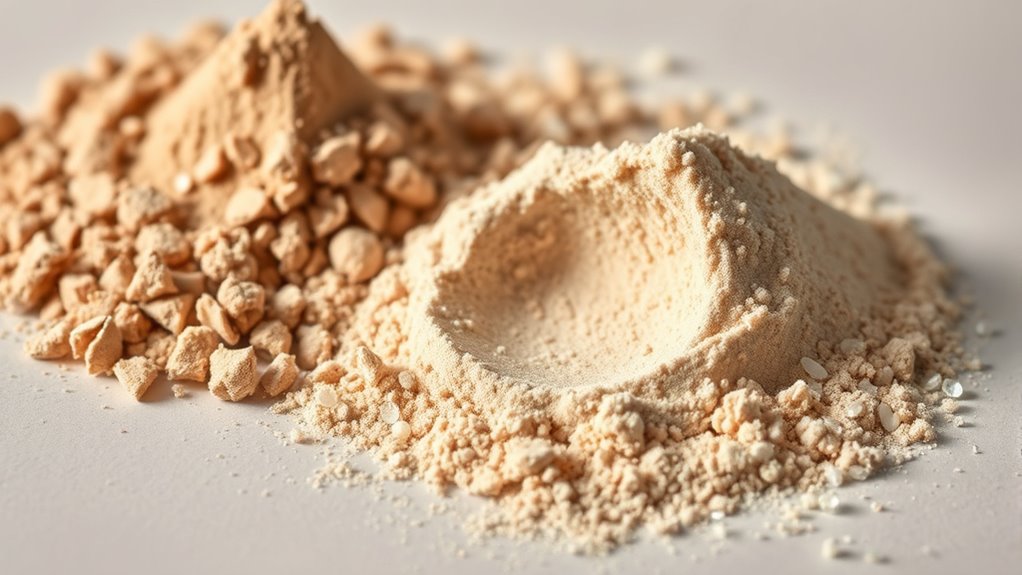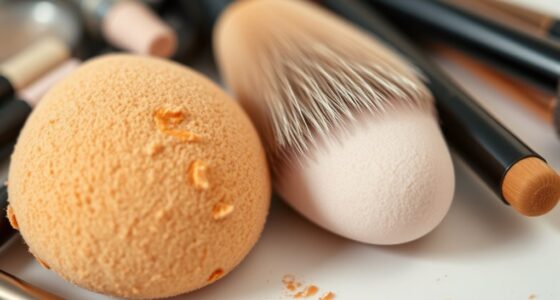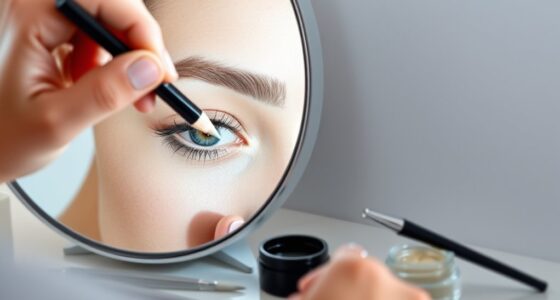Mineral makeup is made from natural minerals like titanium dioxide, zinc oxide, and mica, offering a lightweight, breathable, and skin-friendly option. It provides a natural glow, protects against UV rays, and is non-comedogenic, making it ideal for sensitive or acne-prone skin. Applying it with gentle, circular strokes and layering gradually helps achieve a seamless finish. Want to discover more tips and benefits? Keep exploring to enhance your mineral makeup routine.
Key Takeaways
- Made from natural minerals like titanium dioxide and zinc oxide, offering skin benefits and sun protection.
- Non-comedogenic and suitable for sensitive, acne-prone skin; minimizes irritation and allergic reactions.
- Easy to apply with a fluffy brush; layer gradually for a natural, seamless finish.
- Free from preservatives, dyes, and fragrances, providing a cleaner, minimal ingredient makeup option.
- Provides a lightweight, breathable alternative that enhances natural beauty with a healthy glow.

Are you curious about a natural alternative to traditional cosmetics? If so, mineral makeup might be exactly what you’re looking for. Unlike conventional products filled with synthetic chemicals, mineral makeup is made from finely ground minerals like titanium dioxide, zinc oxide, and mica. These ingredients not only provide a natural glow but also offer real skin benefits. To get the most out of mineral makeup, understanding proper application techniques is essential. When applying, start with a clean, moisturized face. Use a fluffy brush to pick up a small amount of product, tapping off any excess before sweeping it across your skin in gentle, circular motions. This method ensures even coverage and helps you avoid a cakey appearance. For targeted areas or more coverage, layer the product gradually rather than applying a thick layer all at once. If you’re using a liquid or cream primer, let it fully absorb before applying mineral powder to prevent clumping. Additionally, a light-handed approach is key—less is often more when it comes to mineral makeup because it’s highly pigmented and buildable. Take your time blending to achieve a seamless finish that enhances your natural beauty.
Understanding the ingredient benefits is equally important. The minerals in mineral makeup are not just for color—they often contain sun protection properties, thanks to zinc oxide and titanium dioxide, which act as physical barriers against harmful UV rays. This makes mineral makeup a good choice for everyday wear, especially if you’re concerned about sun damage. Furthermore, because these ingredients are non-comedogenic, they won’t clog your pores or cause breakouts, making them suitable for sensitive and acne-prone skin. The presence of antioxidants in mineral makeup can also help calm irritation and reduce inflammation, offering a soothing effect. Unlike traditional cosmetics that may contain preservatives, dyes, or fragrances, mineral makeup generally has a minimal list of ingredients, reducing the risk of allergic reactions. This simplicity is part of its appeal for those seeking cleaner beauty options.
Frequently Asked Questions
Is Mineral Makeup Suitable for Sensitive Skin?
Yes, mineral makeup is suitable for sensitive skin. You’ll find hypoallergenic formulas that minimize irritation and contain natural ingredients, making them gentle on your skin. Since mineral makeup avoids harsh chemicals and synthetic additives, it reduces the risk of breakouts and redness. Just make certain you choose products labeled specifically for sensitive skin, and always do a patch test first to confirm it works well for you.
How Long Does Mineral Makeup Typically Last?
Mineral makeup often lasts around six months to a year, depending on usage and storage. To maximize product longevity, keep your powders in a cool, dry place, and avoid exposing them to moisture or heat. Proper storage tips, like sealing containers tightly, help prevent clumping and contamination. By caring for your mineral makeup this way, you make certain it stays fresh, effective, and beautiful for as long as possible.
Can Mineral Makeup Be Used With Other Skincare Products?
Yes, you can use mineral makeup with other skincare products. To get the best results, apply your skincare first, then use blending techniques when applying mineral makeup. Layering tips include letting each product absorb before adding the next, and using a fluffy brush to blend seamlessly. This approach guarantees your skin stays healthy and your makeup looks natural without caking or clumping.
What Ingredients Should I Avoid in Mineral Makeup?
You should avoid ingredients like harsh chemicals and synthetic fragrances in mineral makeup. For example, if you have sensitive skin, using a product with talc or artificial dyes might cause irritation or breakouts. Always check labels and choose mineral makeup free from these irritants to protect your skin. By doing so, you’ll reduce the risk of inflammation and enjoy a more natural, gentle makeup experience.
Is Mineral Makeup Effective for Acne-Prone Skin?
Yes, mineral makeup can be effective for acne-prone skin. It offers beauty benefits like lightweight coverage that doesn’t clog pores and natural ingredients that soothe irritation. Many find it acts as a gentle acne treatment, reducing breakouts and redness. Just make certain you choose non-comedogenic formulations and avoid ingredients like talc or artificial dyes. When applied correctly, mineral makeup can enhance your look while supporting clearer, healthier skin.
Conclusion
Mineral makeup isn’t just a trend; it’s a choice that reflects your natural beauty and confidence. As you embrace this pure, gentle option, remember that your skin’s health is the canvas of your self-expression. Like a sunrise, it’s a fresh beginning each day. So, choose wisely, and let your radiant confidence shine through—because true beauty starts from within and radiates outward, illuminating your unique essence for all to see.








